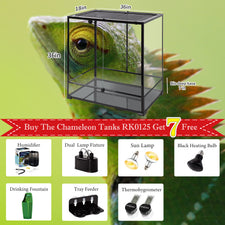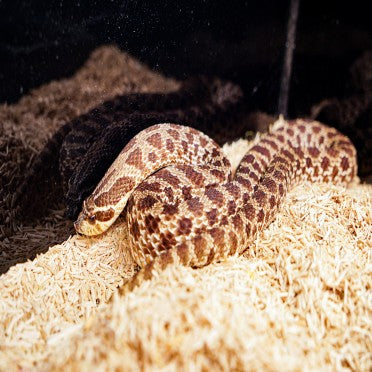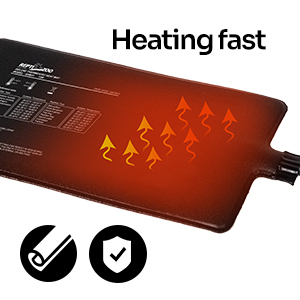Hognose snake is one of the easier pet to take care of and they are immensely popular among the reptile enthusiast. They are known for their captivating defensive behaviors and distinctive upturned snouts that make them unique. They have small to medium size, docile nature, and morphological variation that makes them a great addition to any reptile collection. If you want to keep them in captivity you need to provide proper care and attention to make sure their well-being and longevity. For that reason, we have created this comprehensive care sheet that involves each and every aspect of hognose snake care their habitat, housing, feeding, health, and handling. By following this guideline you can create an enriched environment for your hognose snake.

Different Types of Hognose Snakes
If you are thinking of getting a hognose snake as a pet, it is important to note that there are more than one species available. In reality, there are many species of hognose snakes, like the Western Hognose snake, Eastern Hognose snake, Southern Hognose snake, Tricolor Hognose snake, and the Speckled Hognose snake. Eastern, Western and Southern Hognose snakes are the most common species kept as pets.
How To Care For A Hognose Snake?
Hognose snakes have a very captivating behavior and distinctive appearance; it makes them both low maintenance and fascinating pets. They are also known as “hogs” and they have the capability to capture the heart of anybody. They only require minimal space even if you are living in an apartment.
Snake Tank size
Hognose snakes can be easily raised in a basic snake terrarium that you can get from the nearest pet store. a small size hognose can easily live in it. For an average size hognose you will need a 20-30 gallon terrarium for ample comfort and space. If you are raising some hatchlings then a smaller 5-gallon snake tank can do the work.
When you are buying the enclosure for your hognose snake you will have two options, a plastic cage or a glass terrarium. Both of these can meet the requirements of hognose snakes; if you are getting a glass terrarium always select the one that is 2 feet wide. By selecting this width you can give your snake enough floor space to move freely in the snake enclosure. Unlike the arboreal species, these snakes love to stay on the ground and don’t need any vertical spaces.
Make the hognose snake tank secure
Hognose snakes, love adventures because of their curious nature and they may test boundaries when you will put them in a new snake tank. It is important to make sure that your tank is escape-proof before placing the hognose snake inside it.
These snakes will explore every corner of their tank, goes upside, and even climb the structure placed inside. Hognose need just a hole or crack as big as their skull and they can easily escape, so it is essential to take precautionary measures. If you had bought a terrarium with a screen lid, then you need to fasten it properly. The recommended method is to secure the lid by using the clamps.
If you can add another lid that snaps or slides it can provide an extra layer of security. A lid that just rests on the top of the snake tank can be easily pushed aside by curious hognose snakes. For those cages that have sliding doors, make sure that there will be no gaps between the doors so that hognose snakes can't squeeze through. Keep an eye on other cracks to avoid any escape.
Substrate for snake tank
To make the tank suitable for your hognose snake, you need to add an appropriate substrate to the tank. Hognose snakes have the instinct to dig and burrow, and they use their snouts to get to their prey in the wild. To make sure that your hognose feel just like wild, it is essential to provide a lot of substrate for burrowing. Cypress Mulch and Aspen Shaving are great choices for bedding but if they are not available you can use newspaper or other paper products.
To make the hognose environment more natural you need to add different hiding places so that they can hide and explore the tank. Add things like logs, and small caves that you can easily get from the pet stores. You can also create your DIY hiding places by using plastic boxes and containers.
Hognose snakes are not climbers and like to spend their time on the ground, but sometimes they enjoy climbing. You can also add some branches in the cage to add variety to their environment. Keep an eye on the behavior of your hognose snake and see if they take an interest in the branches and other hiding places. If you feel that they are getting uncomfortable with the branches feel free to remove them.
Light requirement
Hognose don’t have any particular requirement for lighting, but if you provide them lightly on the natural day and night cycle it can provide them overall comfort. Providing them with a light that mimics the pattern of the wild will be beneficial.
While hognose snakes do not need UV lighting, providing them with 10 hours of full spectrum lighting is very useful for their good health. The full spectrum lighting stimulates natural sunlight and provides rays that promote the production of vitamin D3, which is essential for calcium absorption.
Temperature and humidity
Like all other snakes, hognose snakes are ectotherms, which means they need environmental sources to regulate their body temperature. They are unable to generate internal body heat like mammals, so it’s necessary to provide proper warmth.
Maintain the temperature of the enclosure between 75 to 85 degrees F because it allows them to thrive. At night time, drop the temperature to a few degrees, so that it resembles the wild habitat. In order to create warmth in the snake tank use heat tape or the heat mat under the tank. You can also use the heat lamp that can be placed on the screen lid, it will act as a source of lighting and also provide warmth in the snake tank.
Always monitor the temperature in the snake tank for the well-being of your snake. It will be easy for you to notice if the heat lamp is not working, however, it will be difficult to understand when a heat pad stops working. Place an adhesive thermometer inside the snake tank and it will give you complete track of the temperature so that it stays in the appropriate range.
Just like temperature, also keep track of the humidity, western hognose snakes can thrive in low humidity as compared to other species. Try to maintain the humidity level at optimum, the recommended level of humidity is 30% to 50%.
If you look at the humidity requirement for Southern and Eastern hognose snakes they need slightly higher humidity. For these two species, maintain the humidity levels from 50% to 60%. The humidity level can be monitored through a hygrometer; it will help you in maintaining the humidity level within the optimum range that is necessary for hognose snake species.
Handling
Handling your hognose snake is important to make sure that they are adjusted to their new environment. This process usually takes two or more weeks and during that process observe your snake as they explore the enclosure freely.
Once your hognose snake gets adjusted in the snake tank you can start the handling process. The recommended process is to start the handling either on your lap or inside the tank. During the handling process support the snake body with both hands. Make sure that the whole process is smooth and that there are no jerks or sudden movements. Western hognose snakes show some harmless defensive moves when they feel threatened like striking or playing dead. These behaviors are normal and it’s important to give your snake the opportunity to relax and get comfortable with the handling process.
Cleaning of the snake tank
To keep your snake tank clean and healthy for your hognose snake, it's essential to clean it thoroughly at least once a month. To do thorough cleaning follow the steps given below.
- Start the cleaning process by removing all the substrate from the snake tank. This includes any hiding places, branches, or any other furniture placed in the enclosure. Wash all the items like climbing branches, and hiding places with soap and hot water. Make sure that you clean them thoroughly, so all the dirt debris, and potential bacteria are removed.
- You can also use an antibacterial cleaner that is safe to use inside the reptile tanks. Spray the cleaner on the inside floor, walls, and ceiling of the cage. This will help in the removal of bacteria and pathogens that are accumulated inside.
- It is also important to spot-clean the snake tank whenever it is necessary. In the shedding season, when your hognose shed its skin remove the old skin from the enclosure. Furthermore, clean the feces whenever your snake defecates.
- Sterilizing your hognose snake water bowl is also necessary, do it once a week and you can use hot water and soap for this purpose. If your hognose defecates inside the water bowl clean it immediately.
You may refer to this article: How To Clean A Bearded Dragon Tank?
What To Feed Your Hognose Snakes?
Hognose snakes are carnivorous animals and they thrive on a diet that consists of different prey items. In the wild, the main part of their diet is the amphibians like toads and frogs. However, it will be difficult to feed such a diet in captivity, so they can be fed rodents like rats and mice.
Make sure that the size of the snake is proportional to the size of the snake. For baby hognose and juvenile hognose snakes, fuzzies and pinky mice are the best choices. The size of the prey can be increased as the snake grows.
It is important to keep in mind that hognose snakes show specific feeding behavior. They show a defensive mechanism where they play dead or act defensively when they feel threatened. Sometimes hognose snakes don’t eat due to stress or other environmental changes. If your hognose shows any such behavior and doesn’t eat it's best to consult a reptile veterinarian.
The general recommendation is to feed pre-killed prey to your hognose snakes for particular safety reasons. The feeding area should be clean and the prey is not too large so that the hognose can consume it easily.
Usually, frozen prey is fed to the hognose snakes. When feeding frozen items, it is essential to thaw them properly before feeding them to your snake. Thawing can be done easily by placing the frozen mouse in a bucket of warm water for a few hours. After thawing dry off the prey and place it in the snake tank, this will make sure that the prey has the appropriate temperature and is ready for the hognose snake to eat.
What Are The Risks Associated With Feeding Live Prey To Hognose Snakes?
You will find some hognose snakes that prefer to eat only freshly killed prey, if you face such a problem, offer a freshly killed rat or mouse to your hognose snake. Furthermore, some hognose snakes only eat live prey items. Keep in mind that there are many risks associated with feeding live prey to your snake.
When you feed live prey, there are chances that the mouse would harm your snake during the feeding process. Live mice can scratch and bite the snake which leads to many injuries. Additionally, Live prey can also cause anxiety and stress in the snake.
So the general recommendation is to go for the pre-killed or frozen items for the hognose snakes. These options minimize the risks of harm to the snake and are very safe for feeding. If you feel that your hognose snake is not eating and showing a strong preference for live prey, then consult a reptile specialist or vet for alternative feeding techniques.
Conclusion
Caring for a hognose snake is a very rewarding experience. If you understand their needs, about feeding, habitat, and handling you will have a healthy hognose in the snake tank. Remember that every hognose snake is different and their nature may vary. So always keep in touch with your veterinarian about the specific requirement and care techniques to give the best care to your hognose snakes.












